Due to the US Government shutdown, the Smithsonian is temporarily closed. The Global Volcanism Program website will remain available but will not be monitored or updated. Status updates will be available on the Smithsonian homepage.


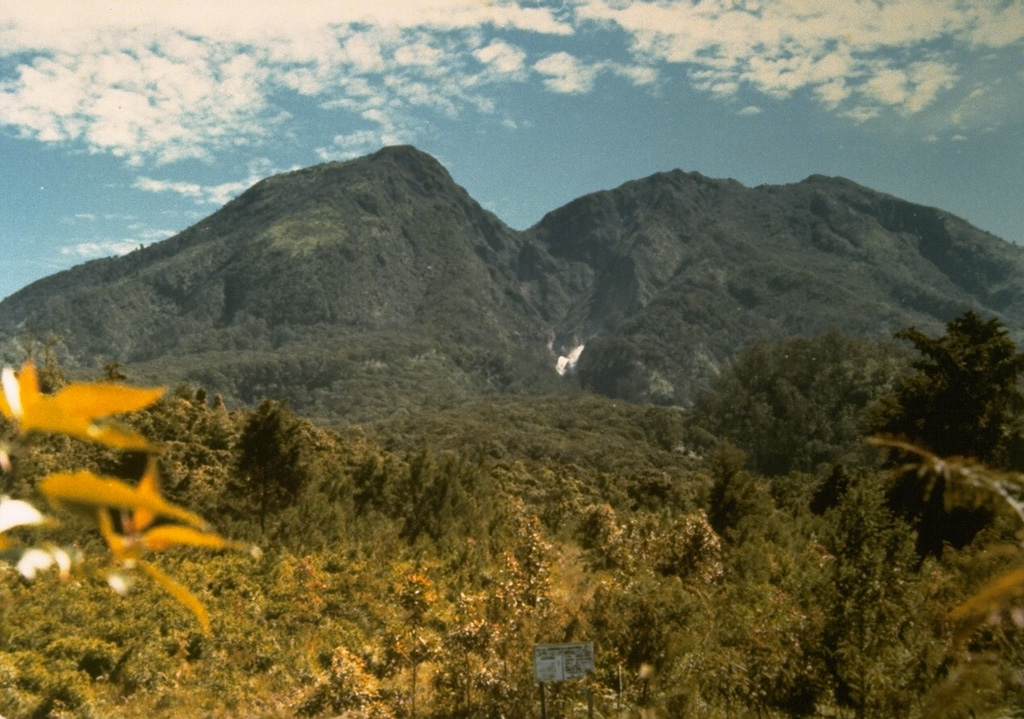
Earthquake swarm during late 1978
The Indonesian newspaper Kompas reported that the first earthquakes of a swarm in the vicinity of the Lawu volcanic complex were felt on 10 December 1978. Area residents reported 14 felt shocks in December, five in January, two in February, six in March, and eight in April. The earthquakes were usually preceded by thunder-like rumbling from the direction of Lawu.
Seismicity became more frequent in late April and early May. At least four felt events occurred on 26 April, including a 10-second earthquake at 1900 that damaged a temple and a transmitting station. On 4 May a landslide in Lawu's Candradimuka Crater (in the S part of the complex) was followed by emission of a thick vapor cloud that was accompanied by a sulfur odor. Between the evening of 4 May and 0700 the next morning, nine events were felt. A total of 27 felt shocks occurred on 5 May, 37 on the 6th, and 35 on the 8th. A series of five earthquakes lasting 4-6 seconds each took place at about 1230 on 9 May. During a 12-hour period 14-15 May, there were more than 1,000 recorded events, more than 50 of which were felt. A VSI team is investigating the seismicity.
Further Reference. Tjia, H.D., and Hamidi, S., 1981, An earthquake swarm around Lawu volcano in Java: Berita Geologi, v. 13, p. 108-111.
Information Contacts: Kompas, Jakarta.
The Global Volcanism Program has no Weekly Reports available for Lawu.
Reports are organized chronologically and indexed below by Month/Year (Publication Volume:Number), and include a one-line summary. Click on the index link or scroll down to read the reports.
Earthquake swarm during late 1978
The Indonesian newspaper Kompas reported that the first earthquakes of a swarm in the vicinity of the Lawu volcanic complex were felt on 10 December 1978. Area residents reported 14 felt shocks in December, five in January, two in February, six in March, and eight in April. The earthquakes were usually preceded by thunder-like rumbling from the direction of Lawu.
Seismicity became more frequent in late April and early May. At least four felt events occurred on 26 April, including a 10-second earthquake at 1900 that damaged a temple and a transmitting station. On 4 May a landslide in Lawu's Candradimuka Crater (in the S part of the complex) was followed by emission of a thick vapor cloud that was accompanied by a sulfur odor. Between the evening of 4 May and 0700 the next morning, nine events were felt. A total of 27 felt shocks occurred on 5 May, 37 on the 6th, and 35 on the 8th. A series of five earthquakes lasting 4-6 seconds each took place at about 1230 on 9 May. During a 12-hour period 14-15 May, there were more than 1,000 recorded events, more than 50 of which were felt. A VSI team is investigating the seismicity.
Further Reference. Tjia, H.D., and Hamidi, S., 1981, An earthquake swarm around Lawu volcano in Java: Berita Geologi, v. 13, p. 108-111.
Information Contacts: Kompas, Jakarta.
|
|
||||||||||||||||||||||||||
There is data available for 0 confirmed eruptive period.
[ 1885 Nov 28 - 1885 Nov 28 ] Discredited Eruption
Figee and Onnen (NTNI, 1887) reported (translated): "The... Resident [at Madiun] states that at Ngrambee, during the night of November 27th to 28th [1885], between 1 and 4 a.m., three dull booms, accompanied by a rumbling noise, were heard from the Lawoe volcano, and that volcanic sand and mud were noted in the rivers emanating from that volcano. On November 28th, at 4 p.m., a light ash rain fell at the aforementioned location." This description is similar to a landslide/avalanche report from 1978, and does not describe any eruption plume or deposit; the "ash rain" noted 12 hours later is more likely avalanche material that was remobilized by winds that afternoon. Steep avalanche scars are visible in satellite imagery (2025) in multiple valleys, especially on the S flank.
[ 1752 May 1 ] Discredited Eruption
An eruption on 1 May 1752 CE (Sapper, 1917; De Neve, 1985b) was actually from Kelud volcano (Neumann van Padang, 1951).
This compilation of synonyms and subsidiary features may not be comprehensive. Features are organized into four major categories: Cones, Craters, Domes, and Thermal Features. Synonyms of features appear indented below the primary name. In some cases additional feature type, elevation, or location details are provided.
Synonyms |
||||
| Lawoe | ||||
Craters |
||||
| Feature Name | Feature Type | Elevation | Latitude | Longitude |
| Dumilah | Crater | |||
| Gamping | Crater | |||
| Gemolong | Crater | |||
| Gesi | Crater | |||
| Gumawang | Crater | |||
| Kuning | Crater | 3220 m | 7° 37' 42.00" S | 111° 11' 40.00" E |
| Lumbung Selayur
Lumbung Selajur |
Crater | |||
| Panggungan | Crater | |||
| Pundutan North | Crater | |||
| Pundutan South | Crater | |||
| Sangiran | Crater | |||
| Sarangan | Crater | |||
| Setupa | Crater | |||
| Telagakuning | Crater | |||
| Telogowuro | Crater | |||
| Tiling | Crater | |||
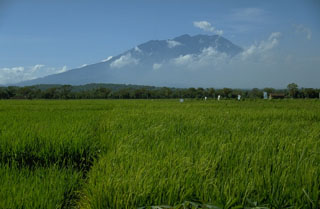 Lawu rises above rice fields on its NW side and occupies much of the area between the cities of Surakarta on the west and Madiun on the east. An eruption in 1885 resulted in minor ashfall.
Lawu rises above rice fields on its NW side and occupies much of the area between the cities of Surakarta on the west and Madiun on the east. An eruption in 1885 resulted in minor ashfall. Lawu dominates the skyline east of the city of Surakarta (Solo). This view is from the south, with a white plume rising from a thermal area at the center of the photo. Lawu was constructed to the north of an older complex during the Holocene. A rift valley between the two volcanoes is occupied on the east by several crater lakes.
Lawu dominates the skyline east of the city of Surakarta (Solo). This view is from the south, with a white plume rising from a thermal area at the center of the photo. Lawu was constructed to the north of an older complex during the Holocene. A rift valley between the two volcanoes is occupied on the east by several crater lakes.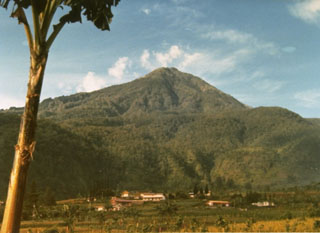 The forested Lawu, seen here from the SW, is located between the cities of Surakarta and Madiun. A trail to the top of the volcano is used for pilgrimages to the Hindu-Buddhist temple near the summit.
The forested Lawu, seen here from the SW, is located between the cities of Surakarta and Madiun. A trail to the top of the volcano is used for pilgrimages to the Hindu-Buddhist temple near the summit.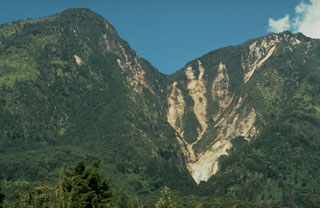 Small plumes rise to the lower right from a geothermal area on the southern flanks of Gunung Lawu at an elevation of 2,550 m. Erosion of hydrothermally altered rocks produces vegetation-free areas.
Small plumes rise to the lower right from a geothermal area on the southern flanks of Gunung Lawu at an elevation of 2,550 m. Erosion of hydrothermally altered rocks produces vegetation-free areas.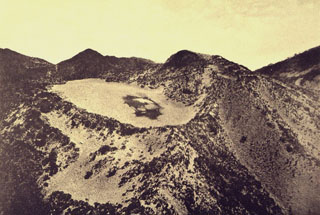 Kawah Kuning crater, at the summit of Gunung Lawu, is seen here in an aerial view from the west. The flat-floored, 250-m-wide crater is truncated by younger craters to the south.
Kawah Kuning crater, at the summit of Gunung Lawu, is seen here in an aerial view from the west. The flat-floored, 250-m-wide crater is truncated by younger craters to the south.There are no samples for Lawu in the Smithsonian's NMNH Department of Mineral Sciences Rock and Ore collection.
| Copernicus Browser | The Copernicus Browser replaced the Sentinel Hub Playground browser in 2023, to provide access to Earth observation archives from the Copernicus Data Space Ecosystem, the main distribution platform for data from the EU Copernicus missions. |
| MIROVA | Middle InfraRed Observation of Volcanic Activity (MIROVA) is a near real time volcanic hot-spot detection system based on the analysis of MODIS (Moderate Resolution Imaging Spectroradiometer) data. In particular, MIROVA uses the Middle InfraRed Radiation (MIR), measured over target volcanoes, in order to detect, locate and measure the heat radiation sourced from volcanic activity. |
| MODVOLC Thermal Alerts | Using infrared satellite Moderate Resolution Imaging Spectroradiometer (MODIS) data, scientists at the Hawai'i Institute of Geophysics and Planetology, University of Hawai'i, developed an automated system called MODVOLC to map thermal hot-spots in near real time. For each MODIS image, the algorithm automatically scans each 1 km pixel within it to check for high-temperature hot-spots. When one is found the date, time, location, and intensity are recorded. MODIS looks at every square km of the Earth every 48 hours, once during the day and once during the night, and the presence of two MODIS sensors in space allows at least four hot-spot observations every two days. Each day updated global maps are compiled to display the locations of all hot spots detected in the previous 24 hours. There is a drop-down list with volcano names which allow users to 'zoom-in' and examine the distribution of hot-spots at a variety of spatial scales. |
|
WOVOdat
Single Volcano View Temporal Evolution of Unrest Side by Side Volcanoes |
WOVOdat is a database of volcanic unrest; instrumentally and visually recorded changes in seismicity, ground deformation, gas emission, and other parameters from their normal baselines. It is sponsored by the World Organization of Volcano Observatories (WOVO) and presently hosted at the Earth Observatory of Singapore.
GVMID Data on Volcano Monitoring Infrastructure The Global Volcano Monitoring Infrastructure Database GVMID, is aimed at documenting and improving capabilities of volcano monitoring from the ground and space. GVMID should provide a snapshot and baseline view of the techniques and instrumentation that are in place at various volcanoes, which can be use by volcano observatories as reference to setup new monitoring system or improving networks at a specific volcano. These data will allow identification of what monitoring gaps exist, which can be then targeted by remote sensing infrastructure and future instrument deployments. |
| Volcanic Hazard Maps | The IAVCEI Commission on Volcanic Hazards and Risk has a Volcanic Hazard Maps database designed to serve as a resource for hazard mappers (or other interested parties) to explore how common issues in hazard map development have been addressed at different volcanoes, in different countries, for different hazards, and for different intended audiences. In addition to the comprehensive, searchable Volcanic Hazard Maps Database, this website contains information about diversity of volcanic hazard maps, illustrated using examples from the database. This site is for educational purposes related to volcanic hazard maps. Hazard maps found on this website should not be used for emergency purposes. For the most recent, official hazard map for a particular volcano, please seek out the proper institutional authorities on the matter. |
| IRIS seismic stations/networks | Incorporated Research Institutions for Seismology (IRIS) Data Services map showing the location of seismic stations from all available networks (permanent or temporary) within a radius of 0.18° (about 20 km at mid-latitudes) from the given location of Lawu. Users can customize a variety of filters and options in the left panel. Note that if there are no stations are known the map will default to show the entire world with a "No data matched request" error notice. |
| UNAVCO GPS/GNSS stations | Geodetic Data Services map from UNAVCO showing the location of GPS/GNSS stations from all available networks (permanent or temporary) within a radius of 20 km from the given location of Lawu. Users can customize the data search based on station or network names, location, and time window. Requires Adobe Flash Player. |
| DECADE Data | The DECADE portal, still in the developmental stage, serves as an example of the proposed interoperability between The Smithsonian Institution's Global Volcanism Program, the Mapping Gas Emissions (MaGa) Database, and the EarthChem Geochemical Portal. The Deep Earth Carbon Degassing (DECADE) initiative seeks to use new and established technologies to determine accurate global fluxes of volcanic CO2 to the atmosphere, but installing CO2 monitoring networks on 20 of the world's 150 most actively degassing volcanoes. The group uses related laboratory-based studies (direct gas sampling and analysis, melt inclusions) to provide new data for direct degassing of deep earth carbon to the atmosphere. |
| Large Eruptions of Lawu | Information about large Quaternary eruptions (VEI >= 4) is cataloged in the Large Magnitude Explosive Volcanic Eruptions (LaMEVE) database of the Volcano Global Risk Identification and Analysis Project (VOGRIPA). |
| EarthChem | EarthChem develops and maintains databases, software, and services that support the preservation, discovery, access and analysis of geochemical data, and facilitate their integration with the broad array of other available earth science parameters. EarthChem is operated by a joint team of disciplinary scientists, data scientists, data managers and information technology developers who are part of the NSF-funded data facility Integrated Earth Data Applications (IEDA). IEDA is a collaborative effort of EarthChem and the Marine Geoscience Data System (MGDS). |